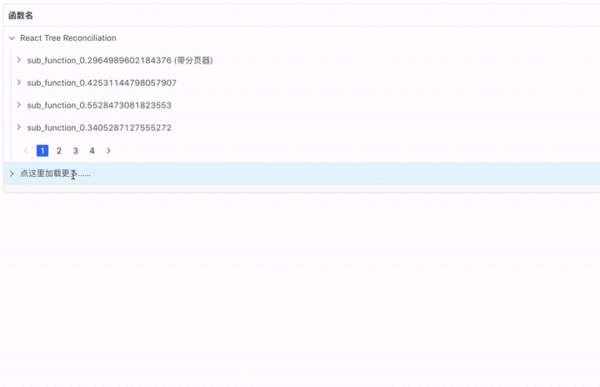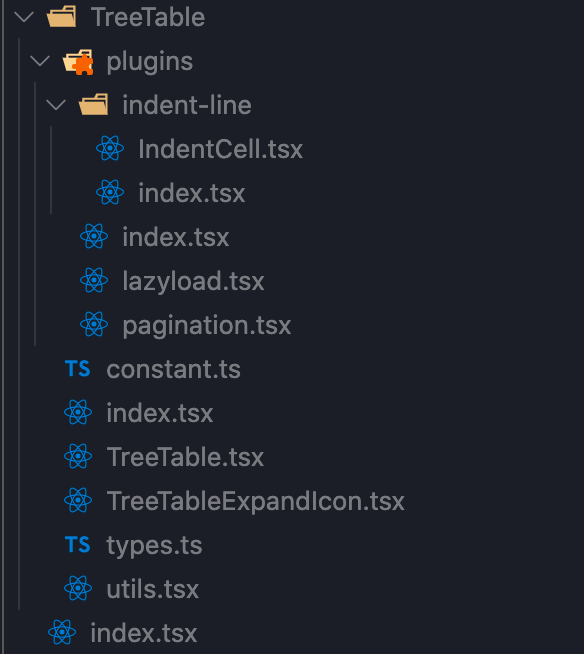本篇内容介绍了“怎么编写插件机制优化基于Antd Table封装表格的混乱代码”的有关知识,在实际案例的操作过程中,不少人都会遇到这样的困境,接下来就让小编带领大家学习一下如何处理这些情况吧!希望大家仔细阅读,能够学有所成!
前言
最近在一个业务需求中,我通过在 Antd Table 提供的回调函数等机制中编写代码,实现了这些功能:
每个层级缩进指示线
远程懒加载子节点
每个层级支持分页
最后实现的效果大概是这样的:

最终效果
这篇文章我想聊聊我在这个需求中,对代码解耦,为组件编写插件机制的一些思考。
重构思路
随着编写功能的增多,逻辑被耦合在 Antd Table 的各个回调函数之中,
指引线的逻辑分散在 rewriteColumns, components中。
分页的逻辑被分散在 rewriteColumns 和 rewriteTree 中。
加载更多的逻辑被分散在 rewriteTree 和 onExpand 中
至此,组件的代码行数也已经来到了 300 行,大概看一下代码的结构,已经是比较混乱了:
export const TreeTable = rawProps => { function rewriteTree() { // ?加载更多逻辑 // ? 分页逻辑 } function rewriteColumns() { // ? 分页逻辑 // ? 缩进线逻辑 } const components = { // ? 缩进线逻辑 }; const onExpand = async (expanded, record) => { // ? 加载更多逻辑 }; return <Table />; };这时候缺点就暴露出来了,当我想要改动或者删减其中一个功能的时候变得异常痛苦,经常在各个函数之间跳转查找。
有没有一种机制,可以让代码按照功能点聚合,而不是散落在各个函数中?
// ? 分页逻辑 const usePaginationPlugin = () => {}; // ? 加载更多逻辑 const useLazyloadPlugin = () => {}; // ? 缩进线逻辑 const useIndentLinePlugin = () => {}; export const TreeTable = rawProps => { usePaginationPlugin(); useLazyloadPlugin(); useIndentLinePlugin(); return <Table />; };没错,就是很像 VueCompositionAPI 和 React Hook 在逻辑解耦方面所做的改进,但是在这个回调函数的写法形态下,好像不太容易做到?
这时候,我回想到社区中一些开源框架提供的插件机制,好像就可以在不深入源码的情况下注入各个回调时机的用户逻辑。
比如 Vite 的插件[1]、Webpack 的插件[2] 甚至大家很熟悉的 Vue.use()[3],它们本质上就是对外暴露出一些内部的时机和属性,让用户去写一些代码来介入框架运行的各个时机之中。
那么,我们是否可以考虑把「处理每个节点、column、每次 onExpand」 的时机暴露出去,这样让用户也可以介入这些流程,去改写一些属性,调用一些内部方法,以此实现上面的几个功能呢?
我们设计插件机制,想要实现这两个目标:
鸿蒙官方战略合作共建——HarmonyOS技术社区
逻辑解耦,把每个小功能的代码整合到插件文件中去,不和组件耦合起来,增加可维护性。
用户共建,内部使用的话方便同事共建,开源后方便社区共建,当然这要求你编写的插件机制足够完善,文档足够友好。
不过插件也会带来一些缺点,设计一套完善的插件机制也是非常复杂的,像 Webpack、Rollup、Redux 的插件机制都有设计的非常精良的地方可以参考学习。
接下来,我会试着实现的一个最简化版的插件系统。
源码
首先,设计一下插件的接口:
export interface TreeTablePlugin<T = any> { (props: ResolvedProps, context: TreeTablePluginContext): { /** * 可以访问到每一个 column 并修改 */ onColumn?(column: ColumnProps<T>): void; /** * 可以访问到每一个节点数据 * 在初始化或者新增子节点以后都会执行 */ onRecord?(record): void; /** * 节点展开的回调函数 */ onExpand?(expanded, record): void; /** * 自定义 Table 组件 */ components?: TableProps<T>['components']; }; } export interface TreeTablePluginContext { forceUpdate: React.DispatchWithoutAction; replaceChildList(record, childList): void; expandedRowKeys: TableProps<any>['expandedRowKeys']; setExpandedRowKeys: (v: string[] | number[] | undefined) => void; }我把插件设计成一个函数,这样每次执行都可以拿到最新的 props 和 context。
context 其实就是组件内一些依赖上下文的工具函数等等,比如 forceUpdate, replaceChildList 等函数都可以挂在上面。
接下来,由于插件可能有多个,而且内部可能会有一些解析流程,所以我设计一个运行插件的 hook 函数 usePluginContainer:
export const usePluginContainer = ( props: ResolvedProps, context: TreeTablePluginContext ) => { const { plugins: rawPlugins } = props; const plugins = rawPlugins.map(usePlugin => usePlugin?.(props, context)); const container = { onColumn(column: ColumnProps<any>) { for (const plugin of plugins) { plugin?.onColumn?.(column); } }, onRecord(record, parentRecord, level) { for (const plugin of plugins) { plugin?.onRecord?.(record, parentRecord, level); } }, onExpand(expanded, record) { for (const plugin of plugins) { plugin?.onExpand?.(expanded, record); } }, /** * 暂时只做 components 的 deepmerge * 不处理自定义组件的冲突 后定义的 Cell 会覆盖前者 */ mergeComponents() { let components: TableProps<any>['components'] = {}; for (const plugin of plugins) { components = deepmerge.all([ components, plugin.components || {}, props.components || {}, ]); } return components; }, }; return container; };目前的流程很简单,只是把每个 plugin 函数调用一下,然后提供对外的包装接口。mergeComponent 使用deepmerge[4] 这个库来合并用户传入的 components 和 插件中的 components,暂时不做冲突处理。
接着就可以在组件中调用这个函数,生成 pluginContainer:
export const TreeTable = React.forwardRef((props, ref) => { const [_, forceUpdate] = useReducer((x) => x + 1, 0) const [expandedRowKeys, setExpandedRowKeys] = useState<string[]>([]) const pluginContext = { forceUpdate, replaceChildList, expandedRowKeys, setExpandedRowKeys } // 对外暴露工具方法给用户使用 useImperativeHandle(ref, () => ({ replaceChildList, setNodeLoading, })); // 这里拿到了 pluginContainer const pluginContainer = usePluginContainer( { ...props, plugins: [usePaginationPlugin, useLazyloadPlugin, useIndentLinePlugin], }, pluginContext ); })之后,在各个流程的相应位置,都通过 pluginContainer 执行相应的钩子函数即可:
export const TreeTable = React.forwardRef((props, ref) => { // 省略上一部分代码…… // 这里拿到了 pluginContainer const pluginContainer = usePluginContainer( { ...props, plugins: [usePaginationPlugin, useLazyloadPlugin, useIndentLinePlugin], }, pluginContext ); // 递归遍历整个数据 调用钩子 const rewriteTree = ({ dataSource, // 在动态追加子树节点的时候 需要手动传入 parent 引用 parentNode = null, }) => { pluginContainer.onRecord(parentNode); traverseTree(dataSource, childrenColumnName, (node, parent, level) => { // 这里执行插件的 onRecord 钩子 pluginContainer.onRecord(node, parent, level); }); } const rewrittenColumns = columns.map(rawColumn => { // 这里把浅拷贝过后的 column 暴露出去 // 防止污染原始值 const column = Object.assign({}, rawColumn); pluginContainer.onColumn(column); return column; }); const onExpand = async (expanded, record) => { // 这里执行插件的 onExpand 钩子 pluginContainer.onExpand(expanded, record); }; // 这里获取合并后的 components 传递给 Table const components = pluginContainer.mergeComponents() });之后,我们就可以把之前分页相关的逻辑直接抽象成 usePaginationPlugin:
export const usePaginationPlugin: TreeTablePlugin = ( props: ResolvedProps, context: TreeTablePluginContext ) => { const { forceUpdate, replaceChildList } = context; const { childrenPagination, childrenColumnName, rowKey, indentLineDataIndex, } = props; const handlePagination = node => { // 先加入渲染分页器占位节点 }; const rewritePaginationRender = column => { // 改写 column 的 render // 渲染分页器 }; return { onRecord: handlePagination, onColumn: rewritePaginationRender, }; };也许机智的你已经发现,这里的插件是以 use 开头的,这是自定义 hook的标志。
没错,它既是一个插件,同时也是一个 自定义 Hook。所以你可以使用 React Hook 的一切能力,同时也可以在插件中引入各种社区的第三方 Hook 来加强能力。
这是因为我们是在 usePluginContainer 中通过函数调用执行各个 usePlugin,完全符合 React Hook 的调用规则。
而懒加载节点相关的逻辑也可以抽象成 useLazyloadPlugin:
export const useLazyloadPlugin: TreeTablePlugin = ( props: ResolvedProps, context: TreeTablePluginContext ) => { const { childrenColumnName, rowKey, hasNextKey, onLoadMore } = props; const { replaceChildList, expandedRowKeys, setExpandedRowKeys } = context; // 处理懒加载占位节点逻辑 const handleNextLevelLoader = node => {}; const onExpand = async (expanded, record) => { if (expanded && record[hasNextKey] && onLoadMore) { // 处理懒加载逻辑 } }; return { onRecord: handleNextLevelLoader, onExpand: onExpand, }; };而缩进线相关的逻辑则抽取成 useIndentLinePlugin:
export const useIndentLinePlugin: TreeTablePlugin = ( props: ResolvedProps, context: TreeTablePluginContext ) => { const { expandedRowKeys } = context; const onColumn = column => { column.onCell = record => { return { record, ...column, }; }; }; const components = { body: { cell: cellProps => ( <IndentCell {...props} {...cellProps} expandedRowKeys={expandedRowKeys} /> ), }, }; return { components, onColumn, }; };至此,主函数被精简到 150 行左右,新功能相关的函数全部被移到插件目录中去了,无论是想要新增或者删减、开关功能都变的非常容易。
此时的目录结构:

目录结构
“怎么编写插件机制优化基于Antd Table封装表格的混乱代码”的内容就介绍到这里了,感谢大家的阅读。如果想了解更多行业相关的知识可以关注亿速云网站,小编将为大家输出更多高质量的实用文章!
亿速云「云服务器」,即开即用、新一代英特尔至强铂金CPU、三副本存储NVMe SSD云盘,价格低至29元/月。点击查看>>
免责声明:本站发布的内容(图片、视频和文字)以原创、转载和分享为主,文章观点不代表本网站立场,如果涉及侵权请联系站长邮箱:is@yisu.com进行举报,并提供相关证据,一经查实,将立刻删除涉嫌侵权内容。